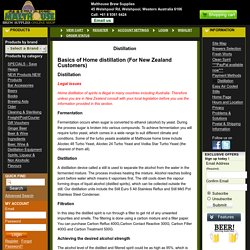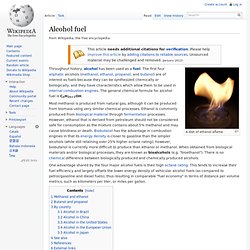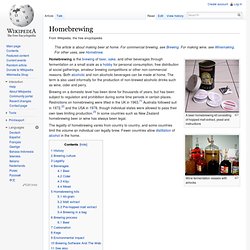

Biofuels. Still Tutorial: A Guide to Building a Column Reflux Still. How to build and operate a still and produce your own alcohol. Building a World Class Home Distillation Apparatus. Biodiesel 2. -- Environmental Defense Fund The Latest Myths and Facts on Global Warming -- In-depth scientific report by Dr.

James Wang and Dr. Michael Oppenheimer, Environmental Defense Fund -- 30 pages, 388 kb pdf: Joint science academies' statement: Global response to climate change -- "Climate change is real": 2-page report signed by the Academia Brasiliera de Ciências, Brazil; Royal Society of Canada; Chinese Academy of Sciences; Academié des Sciences, France; Deutsche Akademie der Naturforscher, Germany; Indian National Science Academy; Accademia dei Lincei, Italy; Science Council of Japan; Russian Academy of Sciences; Royal Society, UK; National Academy of Sciences, USA. 392 kb pdf:
Make your own biodiesel. The first two methods sound easiest, but, as so often in life, it's not quite that simple.

Vegetable oil is much more viscous (thicker) than either petro-diesel or biodiesel. The purpose of mixing or blending straight vegetable oil (SVO) with other fuels and solvents is to lower the viscosity to make it thinner, so that it flows more freely through the fuel system into the combustion chamber. If you're mixing SVO with petro-diesel you're still using fossil-fuel -- cleaner than most, but still not clean enough, many would say. Still, for every gallon of SVO you use, that's one gallon of fossil-fuel saved, and that much less climate-changing carbon dioxide in the atmosphere. People use various mixes, ranging from 10% SVO and 90% petro-diesel to 90% SVO and 10% petro-diesel. You might get away with it in summer time with something like an older '80s Mercedes 5-cylinder IDI diesel, which is a very tough and tolerant motor -- it won't like it but you probably won't wreck it.
To each his own. Biodiesel. Bus run by biodiesel Space-filling model of methyl linoleate, or linoleic acid methyl ester, a common methyl ester produced from soybean or canola oil and methanol Space-filling model of ethyl stearate, or stearic acid ethyl ester, an ethyl ester produced from soybean or canola oil and ethanol Biodiesel refers to a vegetable oil- or animal fat-based diesel fuel consisting of long-chain alkyl (methyl, ethyl, or propyl) esters.

Biodiesel is typically made by chemically reacting lipids (e.g., vegetable oil, animal fat (tallow[1][2])) with an alcohol producing fatty acid esters. Biodiesel is meant to be used in standard diesel engines and is thus distinct from the vegetable and waste oils used to fuel converted diesel engines. The National Biodiesel Board (USA) also has a technical definition of "biodiesel" as a mono-alkyl ester.[3] Blends[edit] Home Distillation. Distillation Legal issues Home distillation of spirits is illegal in many countries including Australia.

Therefore unless you are in New Zealand consult with your local legislation before you use the information provided in this section. Fermentation Fermentation occurs when sugar is converted to ethanol (alcohol) by yeast. Home Distillation of Alcohol (Homemade Alcohol to Drink) Biodiesel - Wikipedia, the free encyclopedia - (Build 2010040106. Home Distillation of Alcohol (Homemade Alcohol to Drink)
To make a grain wort requires Malting, Gristing, Mashing, Brewing, and Fermenting.

Check beer related books, homepages or discussion groups (eg Alan & Melissa's Homebrew, Spensers Beer page), for heaps more details, but don't get put off by some the minutia they sometimes get into. See also ... Avoiding Post-Fermentation ProblemsHow the Mash Makes WortBoiling and HopsBodensatz Brewing Only use grains if you are after flavour (eg making a bourbon or whisky), or if for some reason they are really cheap for you to obtain. Generally, a reflux still will strip out all the flavours and leave a neutral spirit. An excellent way to remove the grains after fermentation is to have used a "grain bag" - eg a large bag made of mesh or muslin to hold the grains. Big tip ! The differences between Scotch whisky, Irish and American whiskeys is outlined at 'The Macallan' site: Scotch whisky It is now generally agreed that there are six regions and these are based on taste as well as geographical location.
Biodiesel 101 - (Build 20100401064631) Alcohol fuel - Wikipedia, the free encyclopedia - (Build 2010040. A dish of ethanol aflame.

The Winemaking Home Page. Biogas - Wikipedia, the free encyclopedia - (Build 2010040106463. Pipes carrying biogas (foreground), natural gas and condensate Biogas typically refers to a mixture of gases produced by the breakdown of organic matter in the absence of oxygen.

Biogas can be produced from regionally available raw materials such as recycled waste. It is a renewable energy source and in many cases exerts a very small carbon footprint. The gases methane, hydrogen, and carbon monoxide (CO) can be combusted or oxidized with oxygen. This energy release allows biogas to be used as a fuel; it can be used for any heating purpose, such as cooking. Biogas can be compressed, the same way natural gas is compressed to CNG, and used to power motor vehicles. Production[edit] Biogas production in rural Germany Biogas is practically produced as landfill gas (LFG) or digested gas. Landfill gas[edit] Landfill gas is produced by wet organic waste decomposing under anaerobic conditions in a landfill.[7][8] The methane in biogas is 20 times more potent a greenhouse gas than carbon dioxide.
Homebrewing. A beer homebrewing kit consisting of hopped malt extract, yeast and instructions Wine fermentation vessels with airlocks Homebrewing is the brewing of beer, sake, and other beverages through fermentation on a small scale as a hobby for personal consumption, free distribution at social gatherings, amateur brewing competitions or other non-commercial reasons.

Both alcoholic and non-alcoholic beverages can be made at home. The term is also used informally for the production of non-brewed alcoholic drinks such as wine, cider and perry. Brewing on a domestic level has been done for thousands of years, but has been subject to regulation and prohibition during some time periods in certain places. The legality of homebrewing varies from country to country, and some countries limit the volume an individual can legally brew. History[edit]